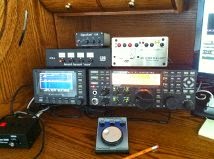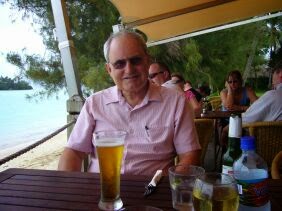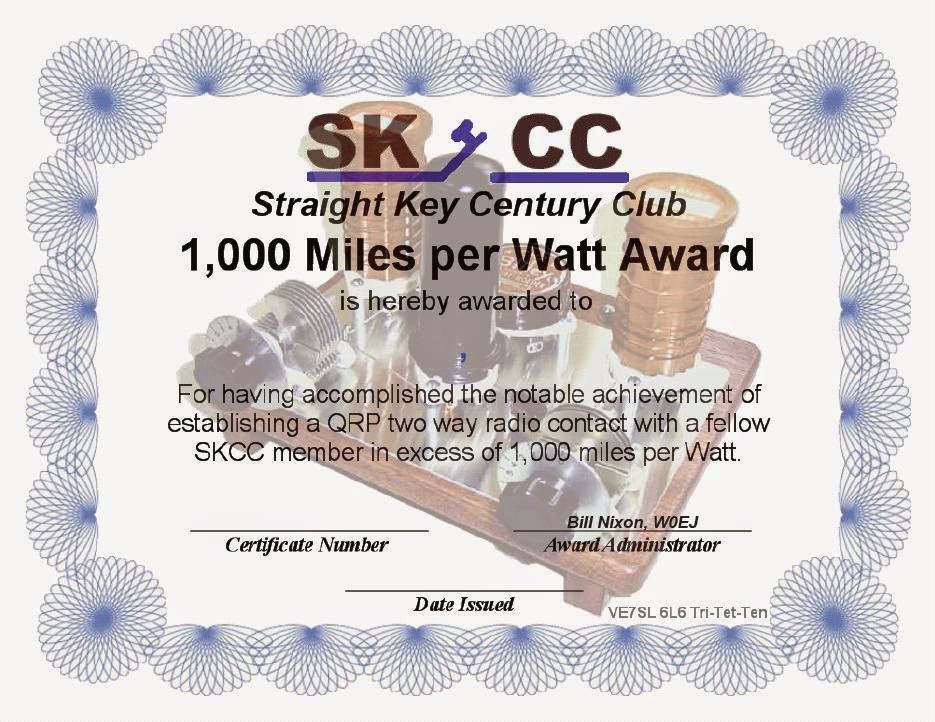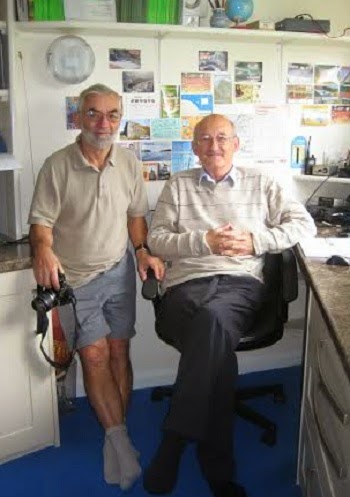 630m Wilkinson Power Combiner
630m Wilkinson Power Combiner
 It's often easier to achieve high power on 630m or LF by combining lower powered amplifiers than it is to build a single high-power rig. A simple Class D push-pull switching FET amplifier can readily produce 400-500W when operated in the 35V range. Combining two such amplifiers, both sharing a common oscillator / driver stage, would yield 800-1000W output...probably much more than needed on 630m.
It's often easier to achieve high power on 630m or LF by combining lower powered amplifiers than it is to build a single high-power rig. A simple Class D push-pull switching FET amplifier can readily produce 400-500W when operated in the 35V range. Combining two such amplifiers, both sharing a common oscillator / driver stage, would yield 800-1000W output...probably much more than needed on 630m. The low parts-count of the amplifier stage in the GW3UEP Class-E transmitter should easily produce 150-200W when run at a slightly higher drain voltage and proper heatsinking. Combining two such modules would yield 300-400W output at very low cost.
Combining can be done with a Two-Way (3-port) Wilkinson Splitter / Combiner. Splitters and Combiners are one and the same, depending on which ends are used for input(s) / output(s). When used in the 'combine' mode, insertion losses are virtually zero and mainly due to the miniscule resistive losses of the coils.
Combiner component values can be calculated the old fashioned way or by using one of the numerous online calculators. This excellent online video by Sebastian (KF5OBS) explains exactly how to calculate component values for the truly dedicated amongst us:
He also has a new video showing how to calculate values for combiners having more than two outputs, should you want to combine three or more individual amplifier modules.
The first combiner I built was for my 2200m kW and combined the output of two 500W Class-D modules:
The air core coils are high-Q, cheap and easy to produce. If space is important, the inductors could just as easily be made using frequency-suitable powdered iron toroids, but at more expense. In actual operation, I have never been able to detect any heat from any of the combiner components, even when running a full kW at lengthy keydown periods of several minutes during QRSS transmissions, affirming the almost 'zero' insertion loss when used in the combining mode.
When I decided to use the same amplifier on 630m, a suitable circuit was designed and built for that band as well:
The terminating / balancing resistor (R) is used only as a safety device in case one of the two amplifiers fails during operation. It allows the still-working amplifier to safely dump some of its power into the load without destroying itself. Under normal operation, no current flows through this resistor so no power is wasted, assuming both inputs are equal. I have read of some schemes that will sense any current flow through 'R' and immediately shutdown the entire transmitter, thus allowing a resistor of lower dissipation to be used for 'R'.
Another benefit of the Wilkinson L-C Combiner is its filtering capability, as it works extremely well as a LPF. Neither my 2200m kW or 630m kW use any low-pass filtering other than that provided by the combiner's L-C network. It also seems to work well as a buffer of sorts, as both myself and VE7TIL noticed with our 2200m systems. We immediately stopped blowing FETs mysteriously when operating at full power. The amplifiers did not seem to react any longer to reactive components suddenly appearing in the antenna system or somewhere in the output network....everything was 100% more stable and reliable it seemed.
I can envision an exciting project consisting of a pair of GW3UEP finals feeding a toroid-based combiner, all in a very small footprint.
Should you choose to combine a pair of amplifiers for 630m, here are the values that were used in my own combiner:
Steve McDonald, VE7SL, is a regular contributor to AmateurRadio.com and writes from British Columbia, Canada. Contact him at ve7sl@shaw.ca.
 Making your radio time interesting is what counts!
Making your radio time interesting is what counts!
Mike Weir, VE9KK, is a regular contributor to AmateurRadio.com and writes from New Brunswick, Canada. Contact him at ve9kk@hotmail.com.
 If this is what Autumn brings
If this is what Autumn brings
I had two very nice DX QSOs during lunch today. These were not "UR 599 TU 73" QSOs, nor were they exactly ragchews. But they were a nice change of pace from the typical "wham, bam, thank you Ma'am" kind of micro-QSOs that seem to be so prevalent these days.
The first was with Vic SM7ZDI who answered my CQ on 18.086 MHz. Vic was using a Yaesu FT-1000D at 100 Watts to a Windom. He had a good 569 signal and gave me the same. Vic told me that it was about 8C (46F) in Sweden. I was very grateful for the 65F (18C) that we had today, when I had heard that.
Larry Makoski, W2LJ, is a regular contributor to AmateurRadio.com and writes from New Jersey, USA. Contact him at w2lj@arrl.net.
 It ended…..
It ended…..
…..the long spell without rain that is. We had over a 100 mm during the last 24 hours in Longtan, but the south of Taiwan was worse off with some serious flooding. The temperature has dropped to a cool 22 degrees Celsius, but the forecast tells us that it will be back up to 35 degrees in no time and it will stay that way for the next week.
Despite it being hot and muggy I did spend some time in the shack on Sunday. Tried to fix the fan in the radiation shield of my weather station, but then my digital multi-meter refused to cooperate. Put the fan aside and spend an hour searching for the problem, but without a second DMM it is kind of difficult. I’ve had this DMM for the last 20 years and it was a gift from my father. It gave me a lot of joy during that time, but there is an end to everything so I am not too sentimental about retiring it. Besides, 20 year old technology is rather dated.
But what to buy as a replacement? The market is flooded with Chinese equipment delivered directly to your door. I am not a professional and only use a DMM for basic measurements and one of those Chinese ones should be good enough for me. On the other hand a nice Fluke would make my future measurements look a bit more professional. So I turned to the internet and the EEVblog website for some advice. Dave has made a buyers guide special on digital multimeters and it is both fun and entertaining to watch. Funny to see my 20 year old instrument in a slightly updated version passing by, but Dave makes pretty convincing points to not buy a similar model again with safety (actually lack of) as the main point. So go for quality and higher specs, but do I really need accuracy better than 0.5% and true RMS measurements? Probably not. But maybe once I get more options or better readings I find that they are really handy and then why have I waited so long in getting them?
Usually I try to find the best value for money. By searching RS and our local eBay site I narrowed down my list to the Agilent U1232A and the Fluke 115, because they are brand names and come out great in tests without being shabby on features. I also looked at lesser known and Taiwanese brands but funnily enough Taiwanese brands like Brymen are hard to get here Taiwan. Chinese brands, on the other hand, are not and one brand stood out a bit, namely Uni-T. Martin Lorton had very indept review of the Uni-T 61E on YouTube and I guess I will go with one of those. They are not the latest greatest, not the fastest, but they seem well build, accurate, safe and only a third of the price of a Fluke 115. A Sunday afternoon well spent and another problem solved.
Hans "Fong" van den Boogert, BX2ABT, is a regular contributor to AmateurRadio.com and writes from Taiwan. Contact him at hans.bx2abt@msa.hinet.net.
 SKCC StraightKey Splendor
SKCC StraightKey Splendor
I was reminded this week of all the fun that the Straight Key Century Club (SKCC) guys are having when receiving a nice e-mail from Bill, W0EJ:
Steve,
Since 2006, this 12,000 strong group of CW diehards have been doing their best to promote the magnificence of the mechanical key in everyday operation. With monthly operating events, awards, Elmering and an online sked page, there are plenty of fun activities for both newcomers and old hands to enjoy what was once the only way to send CW.
I can well recall tuning the CW bands as a newly-licenced teen in the mid 60's. Electronic keyers were just beginning to show up but the vast majority of amateurs still "pounded brass" with a straight key or with some type of bug. I held out for about two years before I parked my straight key and spent my Saturday job money on a brand new Vibroplex original, which I still use from time to time.
Even as late as the early 60's, it was still easy to recognize many stations simply by the rhythm of their fist. Like fingerprints, no two were ever the same except for the truly gifted, who were able to send almost perfect CW by hand ...such an amazing thing to hear and sadly, not heard often anymore....but, not if the SKCC can help it!
Getting back to Bill's mail....I was more than happy to grant permission to use the photograph of my little 6L6 Tri-Tet-Ten that I have had so much fun with over the past few winters on 10m CW during the peak of Cycle 24. I think their new 1000 Miles-Per -Watt award looks just great.....
....and here is what you need to do to earn one for your wall:
SKCC Introduces 1000 MPW Award
The SKCC is rolling out a 1,000 Miles per Watt Award, established to recognize the achievement of contacting another SKCC member using QRP power limits over longer distances.
A QSO must meet the qualifications of (Distance of QSO) / (Power Output in Watts) = 1,000 miles or more. Only the station applying for the award must operate at QRP levels. QSOs made on or after Sept. 1, 2014, are eligible.
For full details, see the award's main page.
Please check out the SKCC's homepage and consider signing-up...or drop by the K3UK SKCC Sked Page and get in on the fun....but, be sure to leave your keyer unplugged and enjoy some straight-key splendor!
Steve McDonald, VE7SL, is a regular contributor to AmateurRadio.com and writes from British Columbia, Canada. Contact him at ve7sl@shaw.ca.
 G3TFX visit
G3TFX visit
Just before lunch, Richard G3TFX called in on his bike. He was on the way to his granddaughter’s birthday party in the village.
This is a photo of us in my shack. Richard is on the left. He is a regular visitor.
It was Richard’s alertness that probably saved my life a year ago. I shall always owe him a debt of gratitude. Richard has recently returned to the hobby. He is usually on 40m SSB, but is fighting a very high noise level on RX. Already he has worked some impressive DX.
Roger Lapthorn, G3XBM, is a regular contributor to AmateurRadio.com and writes from Cambridge, England.
 Series Seven Episode Nineteen – Leixen VV-898 Review (21 September 2014)
Series Seven Episode Nineteen – Leixen VV-898 Review (21 September 2014)
Series Seven Episode Nineteen of the ICQ Amateur / Ham Radio Podcast has been released. The latest news, Martin (M1MRB & W9ICQ) and Colin (M6BOY) discuss changes to Ofcom licence changes and Martin (M1MRB & W9ICQ) and Chris Howard (M0TCH) review the Leixen VV-898,
- New RSGB Youth Committee
- LTE test transmissions in amateur / ham radio 2.3 GHz band
- SB6 Ultra Portable 6m Beam
- Noble Radio NR-4SC 4 Meter SSB/CW Transceiver
- US Amateur Radio vanity callsign fee set at $21.40
- Friedrichshafen presentations available online
- Send your message 'from the Moon'
- The Ham Radio Un-Club
- California QSO Party
- International Air Ambulance Week 2014
- Voodoo Contest Group in Kuwait
- Ofcom Consultation - licence changes from April 2015
Colin Butler, M6BOY, is the host of the ICQ Podcast, a weekly radio show about Amateur Radio. Contact him at info@icqpodcast.com.























